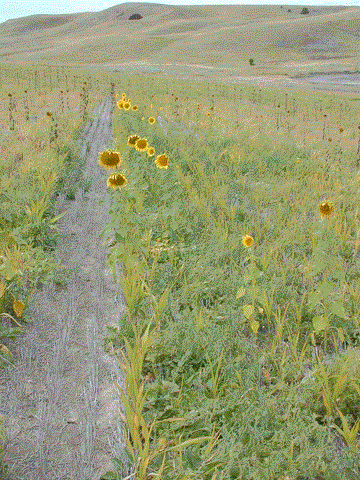Cover Crops and Cover Crop Mixtures

Mixed cover crop in October near Amsterdam, MT
Cover crops can potentially improve subsequent crop yields through enhanced soil health and reduced soil erosion, cut fertilizer, herbicide and pesticide costs, and protect water quality, all of which can increase farm sustainability. The potential to fulfill these benefits may be increased by using mixed rather than single species cover crops. Although there has been substantial research on single species cover crops, research on mixed species cover crops is in its infancy, so many of the potential benefits are hypothesized rather than known. Species can be selected for desired traits such as fixing nitrogen, producing large amounts of root and shoot biomass, or scavenging resources from deep soil layers. Because each crop in a species mix may respond differently to soil, pest and weather conditions, mixtures may increase cover crop survival, ground cover, biomass and nitrogen production, weed control, duration of growing season, range of beneficial insects attracted or pests deterred and forage options.
Current Research Overview
Our multi-year study, funded by Western SARE, was a collaborative project with Montana producers to look at cover crop mixtures as a partial replacement of fallow in rain-fed cropping systems. We have continued a portion of that study with funding from the Montana Fertilizer Advisory Committee. The results of this study, along with other regional research on cover crops as partial replacement of fallow is presented in four MSU Extension documents:
- Cover Crops: Soil Water and Small Grain Yield and Protein (EB0236)
- Cover Crops: Management for Organic Matter and Nitrogen (EB0237)
- Cover Crops: Soil Health (EB0238)
- Cover Crops as Partial Replacement of Summer Fallow (MT202203AG)
The Crops & Soils 2020 article Cover Crop Management in Semi-arid Regions: Effect on Soil and Cash Crop (pdf) presents some of the results and is available for CCA CEUs.
SURVEY: In the winter of 2015 we sent a survey to 500 Montana producers to learn of their experiences and perspective about mixed species cover crops. The major findings are reported here (cover crop survey report with figures). A short College of Agriculture report is also available, as is the survey.
The collaborators on the WARE study were: Perry Miller, Clain Jones, Cathy Zabinski, Meg Housman and Kristi D'Agati, all from the Department of Land Resources and Environmental Sciences at Montana State University; Susan Tallman, USDA-NRCS Agronomist; Jay Norton from the Department of Ecosystem Science and Management at University of Wyoming; Jane Holzer with the Montana Salinity Control Association; and Carl Vandermolen, Herb Oehlke and Chad Doheny, producers.
For More Information
- Contacts
- Clain Jones, MSU Extension Soil Fertility Specialist, 994-6076, clainj@montana.edu
- Perry Miller, MSU Professor, Sustainable Cropping Systems, 994-5431, pmiller@montana.edu
- Cathy Zabinski, MSU Professor, 994-4227, cathyz@montana.edu
- Susan Tallman, NRCS State Agronomist, susan.tallman@mt.usda.gov
- Presentations, videos, publications and reports
- Links to related resources
